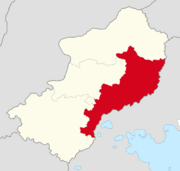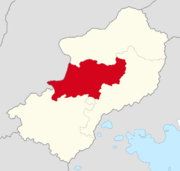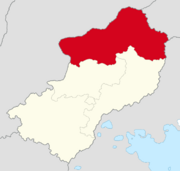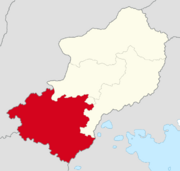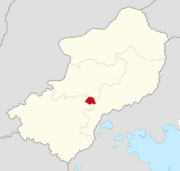Povan Union
| Povan Union |
||||
|---|---|---|---|---|
|
||||
| Capital | Säromos | |||
| Official languages | Ledzib (various dialects) Arkihanakh |
|||
| Recognised national languages | Neviran Osuri |
|||
| Ethnic groups | 65.5% Povan 8.7% Adzamasiin 6.3% Neviran 5.6% Taygo 5.2% Kon 8.7% others |
|||
| Demonym | Povan | |||
| Government | Confederal presidential constitutional republic | |||
| - | President | Altac'in Ic’vitaviŧen der Sinkaŧ | ||
| - | Vicepresident | |||
| Legislature | Supreme Assembly | |||
| - | Upper house | Assembly of the Republics | ||
| - | Lower house | Council of the Union | ||
| Area | ||||
| - | 1,649,085 km2 636,715.28 sq mi |
|||
| Population | ||||
| - | census | 144.954.571,5 | ||
| - | Density | 87,9/km2 227,3/sq mi |
||
| HDI | 0.810 very high |
|||
| Currency | Povan tange (TGE) | |||
| Time zone | Aramos Time (SCT+3) | |||
| - | Summer (DST) | not observed (SCT) | ||
| Drives on the | right | |||
The Povan Union (Ledzib: Vevli kerekwe/vʲevlʲi kʲeˈrʲekʷe/) (Arkihanakh: þaldiṫuyumû alweywlew Ŧarditsuyumɨ arVeyvrev [θɐː.dʲɪ.tsʷʊ.jʊ.mɨ ɐː.vʲɛj.vrʲɛv]), informally referred to as Povania (Ledzib: Vevle (Ledzib: /vʲevlʲe/) (Arkihanakh: alweywle ArVeyvre [ɐː.vʲɛj.vrʲɛ]) is a confederation located in Lower Ekuosia on the continent of Baredina, and is the sixth-most populous country. It is bordered by Nevira to the east and south, and by Tabiqa to the northwest. The confederation is made up of four constituent countries: Arkihan, Ailmudenje, Arzahu, and the largest, Cimseje.
Povania is mainly inhabited by the Adzo-Neviric groups, mainly the Ledzib and the Arkihanakh, Neviric and Adzamic groups respectively, which arrived in different migrations, the first being the arrival of the Neviric peoples around 2000 BCE.
Historically, the Povan area has been controlled by all three of the major Lower Ekuosian empires, and between those periods was divided into a number of smaller states. Following the collapse of the Saruan Empire, the area formed the Confederation of the Lower Ekuos firstly as a defence against Nevira, but after several revolutions and political changes became allied with them against other regional powers, namely Tabiqa. Whilst sufficiently stable during its early existence, in the late 30s various crises led to a takeover by Kúúlist forces, an invasion by both Neviran and Tabiqan forces, culminating in the Povan War between Tabiqa and Nevira. Over the years since then, states within the confederation have themselves united up until the modern day, leaving the four constituent countries that make up the modern-day Povan Union.
Etymology
The adjective "Povan" refers to the Povan Valley, an area in the eastern part of the country that drains into the Povi River, the largest river contained entirely within Povania. Well, it might. Subject to change.
History
Human history of the Povan region, also known as Povania, dates back to hundreds of thousands of years ago, when humans first migrated south from Tabiqa.
Agriculture is thought to have spread to the Povi Valley in 7000 BCE, with permanent settlements being founded along riverbanks as early as 5000 BCE. Exactly which civilizations existed in the area remain under dispute, but scientific consensus is that by 3000 BCE the confluence of the Ekuos and the Povi rivers had become the focal point of the Pela Pola civilization. Its population consisted primarily of Dekanian peoples, who had migrated to the region after being displaced from Nevira in about 3200 BCE. The Pela Pola civilization collapsed in 2500 BCE for reasons unknown.
The Adzo-Neviric group settled in Povania no later than 2200 BCE, thought to be speaking the Proto-Adzo-Neviran language. This group is believed to be the ancestors of the current Adzamasi ethnic group. They were largely driven out by the Dekanians after a few centuries.
(some other stuff in which povans were divided or subjugated, ouch)
In the aftermath of the Great Ekuosian War, pan-Povanist movements reached a boiling point. The unpopular imperial government of Macjera was overthrown, and starting in 1952 negotiations were held between the new Macjeran government and those of Nevira, Hadobor, Karakir, and Tuyami. The Neviran delegation later walked out of the negotiations, and the remaining states drafted a constitution for the State of Macjerans, Tuyams, and Karakiri. The constitution was adopted by Karakir and Macjera, and then by Tuyami and Hadobor after their elections resulted in pan-Povanist parties gaining power. The other Ekuos Valley states joined between 1954 and 1975. ignore this
Geography
Geology
Climate
Biodiversity
Politics
Government
The federal government of the Povan Union is structured around the framework of a constitutional republic which parallels in many ways the governments of its constituent republics. The Povan constitution guarantees a democratic system of government and a separation of powers, with various mechanisms to prevent any one constituent from overpowering another.
Legislative
The legislative power is vested in the All-Union Council, the legislative body which features a unique tricameral system.
The Council of the Republics (abbreviated as CR) behaves similarly to an upper house. It is composed of 30 from each constituent except for Saromos, which instead sends 20, totalling 140. 10% of these delegates (3, or 2 for Saromos) are elected by their respective republican legislatures. These delegates cannot be affiliated to any political party once elected. The rest, which are allowed to belong to political parties, must be popularly and directly elected, although each constituent is given free will on their system of choice. The CR is the only house with direct legislative initiative.
The Council of the Union (abbreviated as CU) behaves most similarly to a lower house. It follows Terminian federalism, meaning the house is composed of the legislatures of all 5 constituents, totalling 2900 members (1 per 50,000 people). Therefore, all of it is elected by popular vote, which once again varies by every constituent. Due to it's structure, many, very minor parties achieve representation here, in contrast with the CR where most oftenly 4 or 5 parties achieve representstion. It is considered the more "proportional" house, however due to the large amount of deputies, debating legislature is rarely done, and it lacks direct legislative initiative. However, members can propose legislation to the CR, as well as propose amendments, and its vote is required to pass legislation.
The Council of Labour (abbreviated CL) is composed of representatives elected by workers. Workers at an enterprise elect representatives to their city, and those elect other representatives at a higher level until it reaches the CL. All representatives follow an imperative mandate, unlike the other two councils, and cannot belong to any political movement. The basic function of the CL is to work as a tiebreaker, as its vote is not required to pass legislation, its vote can sway the votes in the other two houses by up to 10%. This begins when the CL votes 50% in any given topic, it translates to 5% change in vote in both houses, and every 10% in the CL translates to 1% in the other houses. As such, it can help pass legislation not rejected by a large margin in either or both houses. Exceptions are constitutional amendments and overturning presidential vetos (2/3 of all three houses needed) and passing budgets (1/2 of all three houses needed), where the CL loses its tiebreaker function.
Executive
The executive is headed by the President of the Povan Union, both the head of state and government, commander in chief of the army and highest political position in the country. It is elected by popular vote every 5 years in a joint-ticket with its deputy, the Vice-president of the Povan Union using a two-round system. A president can serve up to 2 consecutive terms. The president, once elected, assembles the cabinet.
Judiciary
Administrative divisions
The Povan Union is a confederation of four republics each of which elects its own government and is highly autonomous. Some provinces have historically been independent nations, while others were created during the early days of the Povan Union through the combination and division of smaller states. 3 of the 4 republics are themselves federal, albeit to different levels. The Povan constitution requires all republics hold a democratic government, but restrictions stop there.
|
Foreign relations
nevira gud
Military
Economy
Transport
The Povan Union has an expansive and diverse transportation network. The main corridor for trade and international travel is the Ekuos River, a wide river that flows through the west of the country. Millions of tonnes of raw material and finished goods are transported between the Povan Union and other countries along the Ekuos River.
Major roadways, including expressways, are managed by the federal Ministry of Infrastructure. The most travelled route is known as Highway 1, an expressway ranging from two to eight lanes in each direction. Highway 1 is an uninterrupted, limited-access expressway that parallels the west bank of the Ekuos River between international border crossings in Nevira and Tabiqa.
The formation of rail networks across Povania was slow, with some nations opting to only connect their largest cities to the regional network, and other smaller ones refusing to lay down any rail lines at all. As a result, sea transport via rivers, lakes, and canals remained the predominant method of trade in Povania well into the 19th century. Rail lines and road transport grew at the turn of the century, with many states caving to pressure from larger neighbours to create more redundancies in their transport systems.
The Macjeran Imperial Wars and subsequent Great Ekuosian War resulted in the destruction of many rail and road links across the north and center of Povania. Transport infrastructure damaged in the wars often laid in disrepair for decades. It was not until a wave of infrastructure investment from local and Neviran businesses and entrepreneurs led to the establishment of an expressway network across Povania, and the restoration of many old rail lines and the construction of others. A second wave of infrastructure investments, manifesting in the form of national highway projects and public transport, came a decade later, with substantial contributions from Shohuanese businesses and investors.
Energy
Science and technology
Tourism
Demographics
About hunna milli
Ethnic groups
aaaaaaaaa
Urbanisation
Language
Education
Each province maintains its own education curriculum, however all provinces have mandatory education for a minimum of 11 years. All but the most rural areas typically have two or more school boards with jurisdiction over the same area. Over 98% of Povan citizens have the option to enroll their children in a provincially-funded public school or a private school with tuition. In some cities, there may be a third board for education in the Neviran language.
Mandatory education in the Povan Union is divided into classes, with the exception of kindergarten (meta name). Students begin kindergarten the year of their 5th birthday - in most provinces this is a full school week, while some provinces allow parents to opt for only part of the day or week. Each province sets a standard curriculum for each class from kindergarten up to Class 8. In classes 7 through 9, students are guided towards attending either a gymnasium or a pre-trade school, with expectations for the two groups diverging in Class 9.
The gymnasium is designed for students pursuing a formal education in the arts, humanities, social and physical sciences, and mathematics. The pre-trade school, in contrast, is designed for students who intend to enter a trade or profession. Baccalaureate programs require students to have graduated from a gymnasium, while other colleges accept students from pre-trade schools as well as gymnasiums. Some smaller communities may have a gymnasium and pre-trade school in the same institution.
Faith-based education, in which the curriculum is supplemented with Qurosist teachings and doctrine, was formerly common throughout much of the Povan Union until it was outlawed in 2000.
Healthcare
The Povan Union has a mixed public-private healthcare system. Some provinces have universal healthcare, others have subsidies on common procedures and medications, while still others have largely private healthcare. Despite this, union-owned public restrooms, called Kavapriausa, have been standard across every settlement in the union since the 1987 Toilet Bill.
Religion
More than 75% of Povan citizens are adherents of Qurosism. Most other Povans are irreligious, with a minority being of the Tanhunga faith.
Culture
Heritage
Architecture
Literature
Art
Music
Theatre
Film
Cuisine
Sport
The most popular sport in the Povan Union is association football.

